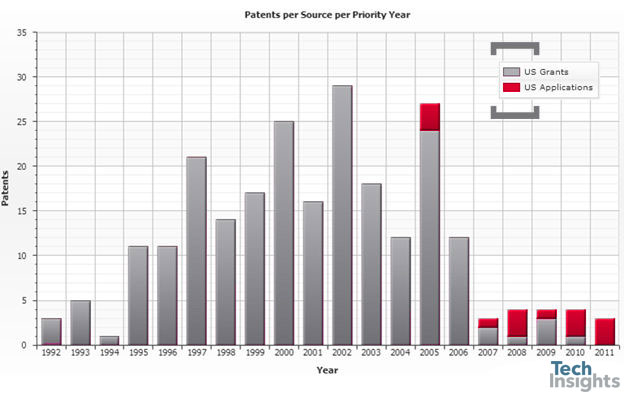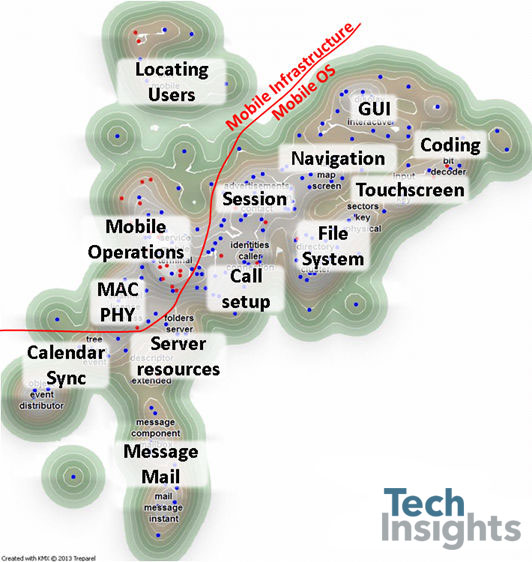Posted: June 20, 2014
Contributing Authors: Martin Bijman
The Chinese government recently revealed Microsoft’s secret list of about 310 Android-killer US patents. TechInsights has taken an initial look at these patents. We found there were actually only 243 unique patents and applications. About 80% of these are applicable to mobile OS, and 20% have elements applicable to mobile infrastructure. The mobile OS patent technologies cover: GUI, coders, touch screen, navigation, file systems, sessions, call setup, server resources, calendar and synchronization, mail and messaging. The mobile infrastructure patents include most of the Rockstar/Nortel patents and cover: operations, MAC, PHY, and locating users.
An initial triage removed patents duplicated in both of the revealed lists, and removed those applications that have been subsequently allowed. The resulting list of 243 patents and applications were considered. About 14% of the patents are from the Rockstar consortium purchase of Nortel patents, which mostly apply to mobile infrastructure, as will be shown later.
The patents were categorized by the type of analysis that would be needed to prove their use: analysis of structures and materials; analysis of semiconductor circuits, or analysis of product systems. Most of the patents are system related, which comes as no surprise. Perhaps a dozen patents have elements that suggest an analysis of semiconductor circuits is needed, which requires deeper investigation but produces evidence of use that is harder for users to work around. These circuit patents include data and motion compression, spatial extrapolation, memory management, as well as encoders and decoders for video and images.
For a broader view of the patents, we inspected their priority year and technology clusters. The priority year of the patents need to be early enough to predate the introduction of these inventions into Android. Android was founded in late 2003, and includes a kernel based on Linux kernel long-term support that was released at roughly the same time. As such, some of the patents would need to have priority at least a year earlier, which is 2002. About 63% of the patents were filed before 2003.

The technology clusters provided in a landscape of the patents were studied to determine the features and functions they are applicable to. The most basic technologies are in the upper right, and moving toward the bottom left, the applications becomes successively higher level. A red line divides the patents; those that are applicable to mobile infrastructure are above the line, and those that are applicable to mobile OS are below the line. Generally, the mobile OS patents may apply to any mobile OS, including Android.

The patents (dots) can be painted to make interesting observations. In this figure, the Microsoft patents are arbitrarily painted blue and the Rockstar/Nortel patents are red. The Rockstar/Nortel patents apply more so to mobile infrastructure than to mobile OS.
Looking at Microsoft litigations, 18 of the 243 patents have been battle hardened since 2008. The largest case uses nine of the patents re Motorola (2010) and their use of Android, in multiple application areas including file system, server resources, radio interface API, context sensitive menu, contact database, synchronizing when offline, and calendar operations. The other cases claim two GUI patents re TiVo (2010), three file system patents re TomTom, one remote software download patent re Salesforce (2010), and five GUI patents re Barnes & Noble (2011).
There are 10 to 20 patents in each of the application area clusters. With a typical hit rate of approximately 5% to 10% for what is likely a hand selected list of patents, it is probable that many of these areas could be shown to have evidence of use, giving a broad coverage of features that are important to consumers. From a top level analysis, there seems to be a solid technology and patent base to support a licensing campaign.








